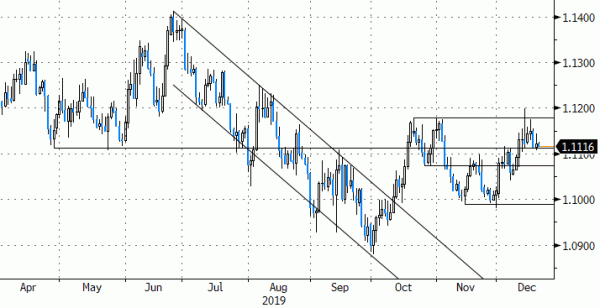- Rates: German and US 10-yr yields test resistance levels
The US and German 10-yr yield intensively test resistance levels. Yesterday’s test was aborted after a dismal Philly Fed Business Outlook. We advocated that stronger data would be necessary to force a next upleg in yields, but risks are clearly tilted to a sooner break given current momentum. - Currencies: US and China to rubberstamp partial trade deal early January
EUR/USD managed to eke out gains after disappointing US data yesterday. US Mnuchin said the partial trade deal will be signed early January. Today’s US data is of secondary importance. Quadruple witching might trigger some volatility going into the weekend. PM Johnson will put his Brexitdeal for a first vote in the House of Commons
The Sunrise Headlines
- US stocks markets extended their record run, gaining around 0.5% and cruising to fresh all-time highs. Asian risk sentiment is more mixed this morning with main indices treading water around opening levels.
- US Treasury Secretary Mnuchin told CNBC that the phase one US-China trade deal will be released and signed early January. On USMCA, the new NAFTA deal, he added that it would add 0.5% to GDP growth.
- The FT reports that Andrew Bailey will today be announced as new Bank of England governor. Baily is a former deputy governor of the BoE and currently head of the Financial Conduct Authority. He takes over at the start of February.
- The World Bank warns in its publication “Global Waves of Debt” on the latest wave of debt accumulation in emerging and developing countries which started in 2010 and reached $55tn in 2018, roughly 170% of GDP.
- Japanese inflation slightly accelerated as expected in November. The National CPI measure ex fresh food, watched by the BoJ, rose from 0.4% Y/Y to 0.5% Y/Y but remains miles away from the central’s 2% inflation target
- UK GfK consumer confidence unexpectedly rose from -14 to -11 in December, matching the strongest reading since July. Improving expectations for 2020 led the surge. Lloyds Business Barometer also hit a 5-month high (10 from 9).
- Today’s US economic calendar contains the final revision of US Q3 GDP, November personal income & spending numbers and PCE deflators. December EMU consumer confidence will be released as well
Currencies: US And China To Rubberstamp Partial Trade Deal Early January
US and China to rubberstamp deal early January
EUR/USD was whipsawed on Thursday, though price action developed in a narrow trading range. Gains eked out during European dealings didn’t last as early US investors entered market. Weaker than expected US data took away some shine from the dollar eventually. US Treasury Secretary Mnuchin said the phase one trade deal text is undergoing a technical and legal review but should be released and signed early January. EUR/USD closed at 1.1122, marginally up from 1.1114. USD/JPY declined from 109.55 to 109.37.
Overnight newsflow is very scarce. Wall Street set new all-time highs again yesterday, but Asian equity markets are struggling for direction this morning. Trading needs new drivers as there are only few data available (until year-end) and major event risks turned less of an issue for the short term lately. South Korean stocks slightly outperform. EUR/USD is trending down, trading in the low 1.11 area (1.1117). The Japanese yen gains a tad on stronger than expected (core) inflation (0.8% y/y vs. 0.7% expected). USD/JPY trades near 109.3.
Today’s economic calendar is centred around the US. The final reading of Q3 GDP is due. Personal income and spending are worth watching but are unlikely to trigger a lasting market reaction. Same goes for the (core) PCE deflator, expected at 0.2% m/m (0.1% m/m) and 1.4% y/y (1.5% y/y) as inflation isn’t the Fed’s main concern at the current stage. Quadruple witching might cause some intraday volatility though. EUR/USD settled in the higher part of the 1.10/1.12 range by the end of last week. The ‘return of Brexit’ made a break beyond 1.12 difficult however. EUR/USD turned back lower in that ST range. We turned neutral on EUR/USD recently and keep that bias for today. The 1.1097 previous neckline marks ST support.
Awful UK retail sales in November had a fairly limited impact on sterling yesterday, as had the Bank of England. The central bank held rates stable (with a 7-2 majority) and kept options for either a rate cut (in case of entrenched uncertainty) or hike (orderly trade and Brexit outcome) open. Sterling lost a few tiks in afternoon trading. EUR/GBP closed at 0.855, up from 0.85. Johnson will put his Brexitdeal to a (first) vote in the House of Commons today. It’s widely expected to be approved with ease and should have no significant impact on sterling. We maintain our neutral view with EUR/GBP hovering near its ST 0.85 equilibrium.
EUR/USD returns in established range. Topside test rejected, ST support kicks in at 1.1097














